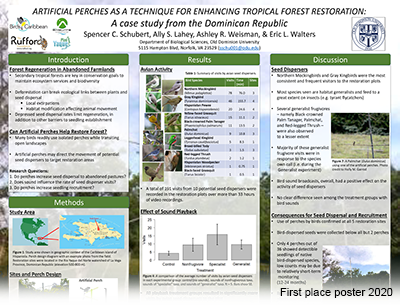College
Batten College of Engineering and Technology
Program
Ph.D. Engineering - Mechanical Engineering
Publication Date
Spring 2020
DOI
10.25883/nq65-4a74
Abstract
Natural materials are made from weak constituents, yet exhibit an excellent synergy of high stiffness, strength, and damage-tolerance. They consist of alternate layers of the hard and soft phases with a complex hierarchical structural organization. The ice-templating technique provides an approach to fabricate multilayered architectures for engineering applications. In this technique, an aqueous ceramic suspension is solidified unidirectionally leading to phase separation into alternating layers of ice-crystals and ceramic particles. Ice-crystals are sublimated by freeze-drying process and resultant ceramic foams are sintered to impart strength. The fabricated sintered ceramic foams contain alternate layers of oriented ceramic lamella walls and pores. By infiltrating the ceramic foams with a polymer phase, ice-templated ceramic-polymer multilayered composites are developed. These ice-templated composites with alternate layers of ceramic and polymer have the potential to exhibit an unusual combination of both improved strength and toughness. This presentation discusses the on-going work on processing and uniaxial axial compressive behavior of ice-templated alumina-epoxy composites quasistatic loading regime. Further presents the influence of ceramic composition on the compressive strength, and the effect of loading orientation on the mechanical response. Additionally, we characterized the compressive strength of porous scaffolds as a function of ceramic composition and loading orientation. To this end, we performed a Weibull analysis study to quantify the variability of compressive strength in ice-templated porous scaffolds and alumina-epoxy composites to understand the role of the ceramic phase in the compressive mechanical response. To visualize and better understand the underlying differences between the deformation characteristics as a function of loading orientation we performed X-ray tomography (XRT) on partially deformed alumina-epoxy composites. This study will enable in understanding the effects of ceramic layer thickness, layer connectivity, and layer orientation with respect to loading orientation in the overall mechanical response of ice-templated alumina-epoxy composites.
Keywords
Natural materials, Ice-templating technique, Compression, Composites
Disciplines
Ceramic Materials | Mechanical Engineering | Polymer and Organic Materials
Files
Download Full Text (2.6 MB)
Recommended Citation
Akurati, Sashanka; Marin, Justine; and Ghosh, Dipankar, "Loading Orientation Dependence on the Compressive Response of Ice-Templated Ceramic-Polymer Composites" (2020). College of Engineering & Technology (Batten) Posters. 1.
https://digitalcommons.odu.edu/gradposters2020_engineering/1

Included in
Ceramic Materials Commons, Mechanical Engineering Commons, Polymer and Organic Materials Commons


